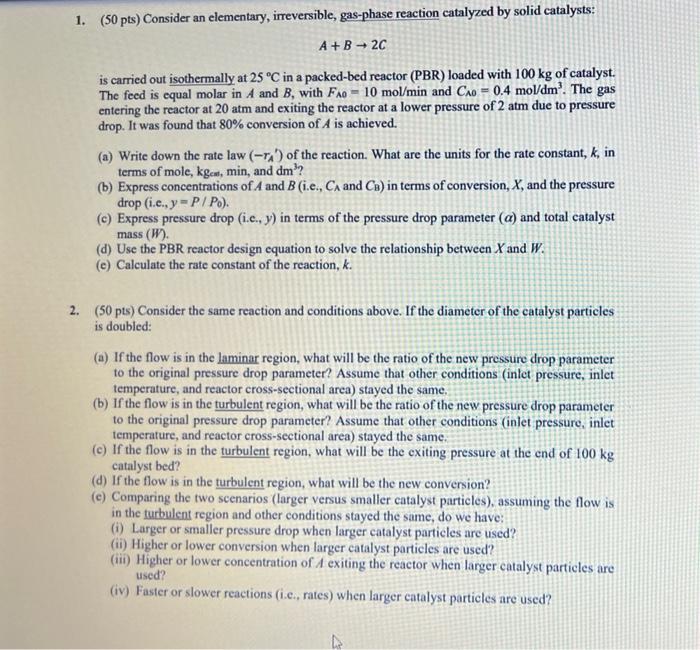1. (50 pts) Consider an elementary, irreversible, gas-phase reaction catalyzed by solid catalysts: A + B + 20 is carried out isothermally at 25 C in a packed-bed reactor (PBR) loaded with 100 kg of catalyst. The feed is equal molar in A and B, with FA - 10 mol/min and Cao = 0.4 mol/dm'. The gas entering the reactor at 20 atm and exiting the reactor at a lower pressure of 2 atm due to pressure drop. It was found that 80% conversion of A is achieved. (a) Write down the rate law (-0) of the reaction. What are the units for the rate constant, k, in terms of mole, gem, min, and dm'? (b) Express concentrations of A and B (i.e., CA and Ca) in terms of conversion, X, and the pressure drop (i.c., y =P/Po). (c) Express pressure drop (i.e. y) in terms of the pressure drop parameter (a) and total catalyst mass (W). (d) Use the PBR reactor design equation to solve the relationship between X and W. (e) Calculate the rate constant of the reaction, k. 2. (50 pts) Consider the same reaction and conditions above. If the diameter of the catalyst particles is doubled: (a) If the flow is in the laminar region, what will be the ratio of the new pressure drop parameter to the original pressure drop parameter? Assume that other conditions (inlet pressure, inlet temperature, and reactor cross-sectional area) stayed the same. (b) If the flow is in the turbulent region, what will be the ratio of the new pressure drop parameter to the original pressure drop parameter? Assume that other conditions (inlet pressure, inlet temperature, and reactor cross-sectional area) stayed the same, (c) If the flow is in the turbulent region, what will be the exiting pressure at the end of 100 kg catalyst bed? (d) If the flow is in the turbulent region, what will be the new conversion? (e) Comparing the two scenarios (larger versus smaller catalyst particles), assuming the flow is in the turbulent region and other conditions stayed the same, do we have: (i) Larger or smaller pressure drop when larger catalyst particles are used? (ii) Higher or lower conversion when larger catalyst particles are used? (iii) Higher or lower concentration of A exiting the reactor when larger catalyst particles are used? (iv) Faster or slower reactions (ie, rates) when larger catalyst particles are used







